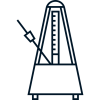Behaviourism
Find out how Pavlov developed Behaviourist theory and my thoughts on applying it in the teaching and learning setting.
What is Behaviourism?
In the 19th Century, Ivan Pavlov, a Russian Psychologist performed a series of tests focusing on salivary secretion and stimuli in dogs.
Pavlov hypothesised that when food was placed in front of his dogs, they would salivate. He noticed, however, that the dogs began to salivate in anticipation of having food placed in front of them when they heard the attendants footsteps.
He tested this observation further by ringing a bell just as the dogs were presented their food. After doing this a number of times, he rang the bell without producing the food stimulus and confirmed that the dogs began to salivate in response to the bell.
Pavlov’s studies lead to what is known as Classical Conditioning – the first systematic study of the basic laws of learning/conditioning.
Pavlov's Experiment

Unconditioned Stimulus (UCS)
The object/event that originally produces a reflexive/natural response

Unconditioned Response (UR)
The response

Neutral Stimulus (NS)
A new stimulus that doesn’t produce a response

No response
In an effort to associate the Neutral Stimulus with the Unconditioned Response, the Neutral Stimulus is introduced at the same time as the Unconditioned Stimulus.

Neutral stimulus (NS)

Unconditioned Stimulus (UCS)
Resulting in...

Conditioned Stimulus (CS)
The neutral stimulus that has become associated with the Unconditioned Stimulus

Conditioned Response (CR)
The new response to the conditioned stimulus
Other major contributors
John B. Watson (1878-1958)
- Watson further developed Pavlov’s classical conditioning into Behaviourism
- An American Psychologist (study focus: conditioning)
- Eventually left psychology to pursue advertising to apply his research findings
- Famous for the ‘Little Albert’ experiment where he conditioned a 9-month-old boy to fear white rats by associating them with a loud, frightening noise
B.F. Skinner (1904-1990)
- An American Psychologist (study focus: operant conditioning)
- Felt that classical conditioning was too simple and therefore did not fully explain complex human behaviour
- Trained rats to press levers to receive food (ie. action versus consequence)
Applying Behaviourist Theory to Learning
As discussed, Behaviourism believes that learning occurs in response to the environment (‘conditioning’) and change occurs when the new behaviour is reinforced with a reward.
It is an appropriate learning theory when :
- We want to elicit a certain behaviour
- There is a only one correct answer to give
Instruction that is underpinned by Behaviourism typically requires:
- Repetition
- Memorisation
- Question & Response
- External Motivators
Sample Activity: Memorisation of Medication Uses & Associated Side Effects
In nursing education, medication uses and side effects are often memorised by rote. Due to the repetition and memorisation of ‘only one correct answer’, this learning scenario has behaviourism at its core.
This experience could be further enhanced however by utilising an online drag and drop quiz (question and response) which is gamified by including an open leader board for top scores. Points would be awarded for both correct answers as well as the speed at which the questions are answers much like a Kahoot quiz. The ‘game’ could be played over and over to allow scorers to attempt to beat their peers while at the same time helping them to memorise the medications, medication families and side effects with further repetition.
Stimulus: Gamified Quiz with an open leader board
Response: Correct Answer
Reinforcement: Positive reinforcement for correct answers (more points) and speed (to gain more points and beat your peers).
The Pros and Cons of Behaviourist Theory for Learning
References
Braungart, M., Braungart, R., & Gramet, P. (2011). Applying Learning Theories to Healthcare Practice. In S. Bastable, P. Gramet, K. Jacobs & D. Sopczyk, Health Professional as Educator: Principles of Teaching and Learning. Ontario: Jones & Bartlett Publishers.
DeAngelis, T. (2020). Mystery solved: We now know what happened to Little Albert. Retrieved 2 October 2020, from https://www.apa.org/monitor/2010/01/little-albert
Drew, C. (2020). Behaviorism – Skinner’s Education Learning Theory (2020). Retrieved 3 October 2020, from https://helpfulprofessor.com/behaviorism/#Pros_and_Cons_Behaviorism_in_Education
Graham, G. (2020). Behaviorism (Stanford Encyclopedia of Philosophy). Retrieved 2 October 2020, from https://plato.stanford.edu/entries/behaviorism/
Kohn, A. (2005). Unconditional parenting: Moving from rewards and punishments to love and reason. New York: Atria.
Mcleod, S. (2020). Pavlov’s Dogs Study and Pavlovian Conditioning Explained | Simply Psychology. Retrieved 2 October 2020, from https://www.simplypsychology.org/pavlov.html
Mcleod, S. (2020). B.F. Skinner | Operant Conditioning | Simply Psychology. Retrieved 2 October 2020, from https://www.simplypsychology.org/operant-conditioning.html
Kompa, J.S. (n.d.). Strengths and Limitations of Behaviorism for Human Learning. Retrieved 2 October 2020, from https://joanakompa.com/2015/05/02/strengths-and-limitations-of-behaviorism-for-learning/
The Nobel Prize in Physiology or Medicine 1904 | Ivan Pavlov Biographical. (2020). Retrieved 2 October 2020, from https://www.nobelprize.org/prizes/medicine/1904/pavlov/biographical/
